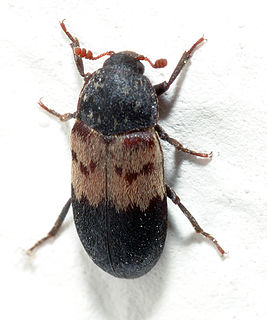
Dermestes is a genus of beetles in the family Dermestidae, the skin beetles. The genus is distributed worldwide.
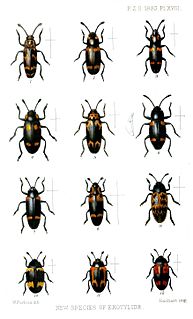
Erotylidae, or the pleasing fungus beetles, is a family of beetles containing over 100 genera. In the present circumscription, it includes the subfamilies Dacninae, Encaustinae, Erotylinae, Megalodacninae, and Tritominae. In other words, the narrowly circumscribed Erotylidae correspond to the subfamily Erotylinae in the definition sensu lato. They feed on plant and fungal matter; some are important pollinators, while a few have gained notoriety as pests of some significance. Sometimes, useful and harmful species are found in one genus, e.g. Pharaxonotha. Most pleasing fungus beetles, however, are inoffensive animals of little significance to humans.
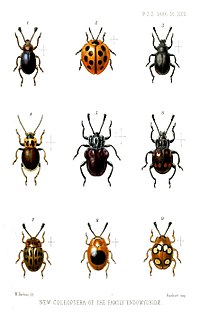
Endomychidae, or handsome fungus beetles, is a family of beetles with representatives found in all biogeographic realms. There are around 120 genera and 1300 species. The family was established based on the type genus Endomychus, a genus erected in 1795 by Panzer which was applied to a species that Linnaeus called Chrysomela coccinea. As the common name suggests, Endomychidae feed on fungi. Crowson, in his influential treatment of the beetles, placed the family within the Cucujoidea. They have a tarsal formal of 4-4-4 or 3-3-3 and the wings lack a closed radial cell. The second antennal segment has a sensory appendage that is as long as the third antennal segment. The family has also been grouped with the Coccinellidae in a group called the Trimera for having pseudotrimerous tarsi. A 2015 molecular phylogeny study found that the Cucujoidea were found to be non-monophyletic and the Endomychidae was refined with the removal of the Anamorphinae from within the family and elevated to the status of a full family, Anamorphidae. Mycetaeinae and Eupsilobiinae were also found not to belong within the clades of the core Endomychidae, and likewise reclassified into the families Mycetaeidae and Eupsilobiidae.

Trogoderma is a genus of beetles in the family Dermestidae, the skin beetles. There are about 135 species worldwide.

Attagenus is a genus of beetles. This genus is found in tropical Africa, the Palearctic including Europe, the Near East, the Nearctic, North Africa and East Asia. There are nearly 200 species. The genus has existed for at least 99 million years, with fossils known from the Cenomanian aged Burmese amber and Turonian aged New Jersey amber.

Megatominae is a subfamily of the beetle family Dermestidae. This subfamily contains several of the most well-known household and stored-product pest beetles, in the genera Anthrenus and Trogoderma.
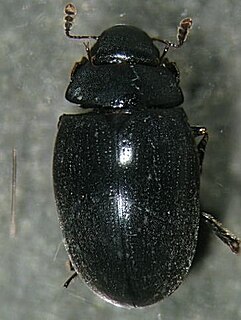
Nosodendridae is a family of beetles, with only 67 species in three genera:

Alexiidae is a family of beetles, in the suborder Polyphaga, formerly included within the family Cerylonidae. Alexiidae are very small, almost half spherical beetles with clubbed antennae. They are fungivores found in leaf litter or decaying wood. The family contains the single genus Sphaerosoma with the following species:
Neoanthrenus is a genus of beetles in the family Dermestidae, containing the following species:
Cryptorhopalum is a genus of beetles in the family Dermestidae, containing the following species:

Orphinus is a genus of beetles in the family Dermestidae, the skin beetles. The genus is distributed in Africa, Asia, and the Australian region, especially in tropical areas; at least one species is cosmopolitan. There are about 88 species.

Phradonoma is a genus of beetles in the family Dermestidae, containing the following species:
Thaumaglossa is a genus of beetles in the family Dermestidae, containing the following species:
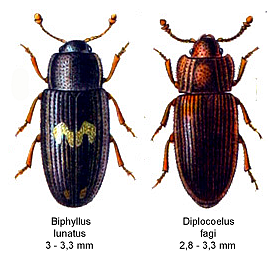
Biphyllus is a genus of beetles in the family Biphyllidae, containing the following species:

Diplocoelus is a genus of beetles in the family Biphyllidae, containing the following species:

Psammoecus is a genus of beetles in the family Silvanidae, containing the following species:

The Anthrenocerus australis is a species of beetle belonging to the dermestidae family. It is commonly known as the Australian Carpet Beetle and is one of the most researched of the thirty-one species in the Anthrenocerus genus. This is generally attributed to its prevalence throughout Australia and New Zealand and the negative economic and agricultural impact it has as a pest. It is the larvae that causes damage to products, not the adult beetle. The total life cycle of this insect is around three years, most of which is spent as a larva. Once the beetle reaches maturity, it only lives for between two and six weeks.
Myrabolia is the only genus in the beetle family Myraboliidae. It has about 13 species, found in Australia.

Phyllopertha is a genus of shining leaf chafers in the beetle family Scarabaeidae. There are more than 20 described species in Phyllopertha, found primarily in the Palearctic.

Prostomis is a genus of beetle in the family Prostomidae.















